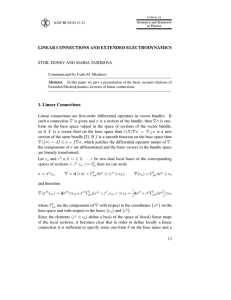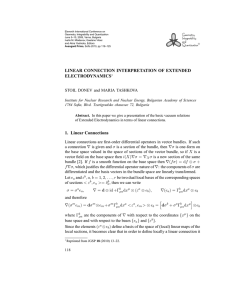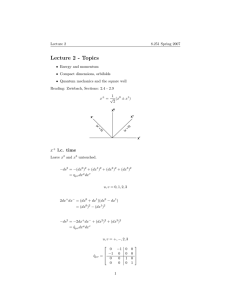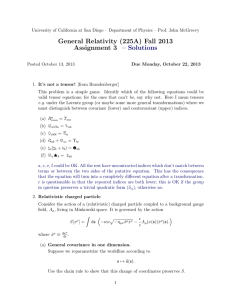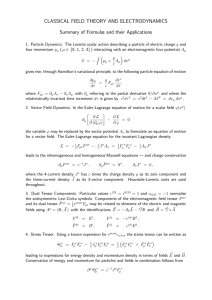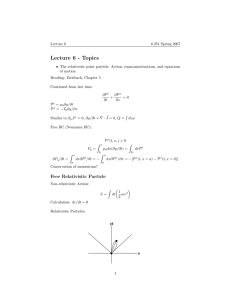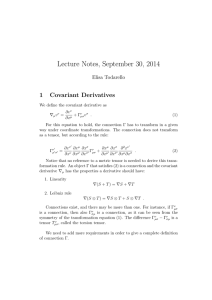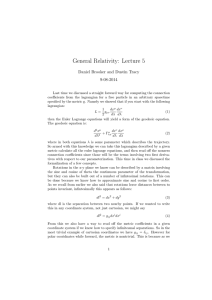Document 13650498
advertisement
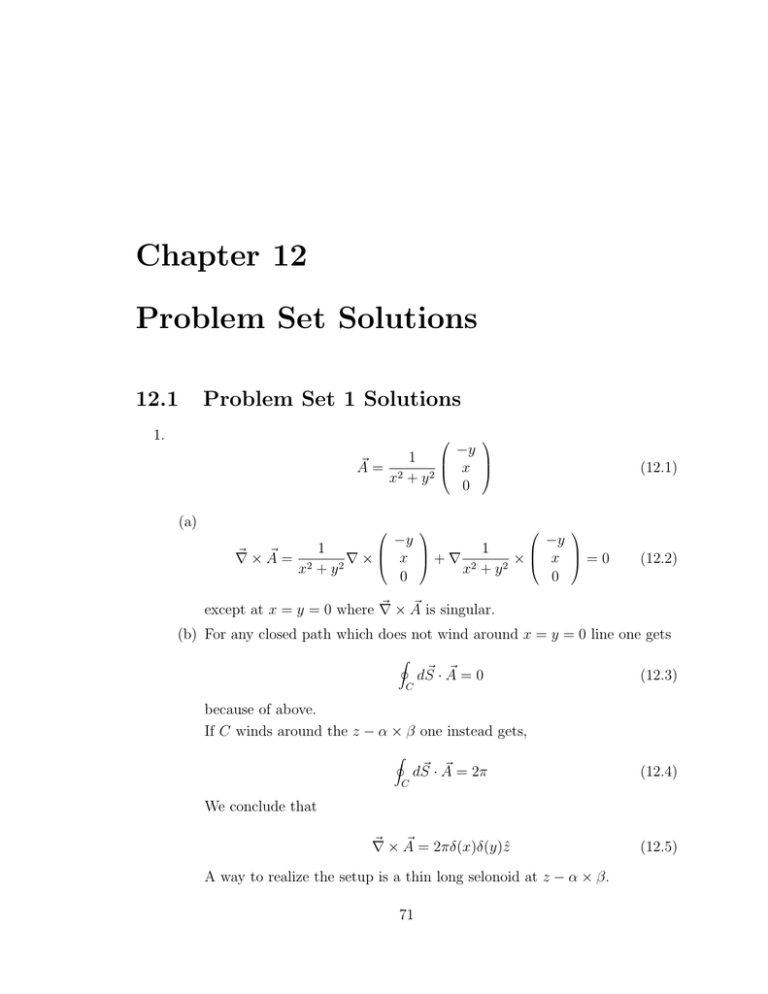
Chapter 12 Problem Set Solutions 12.1 Problem Set 1 Solutions 1. ⎛ ⎞ −y 1 ⎜ ⎟ � A= 2 ⎝ x ⎠ 2 x +y 0 (a) ⎛ ⎞ (12.1) ⎛ ⎞ −y −y 1 1 ⎜ ⎟ ⎜ ⎟ � � � × ⎝ x ⎠ + � 2 × ⎝ x ⎠ = 0 � × A = 2 2 2 x + y x +y 0 0 (12.2) � ×A � is singular. except at x = y = 0 where � (b) For any closed path which does not wind around x = y = 0 line one gets � C � ·A �=0 dS (12.3) because of above. If C winds around the z − α × β one instead gets, � C � ·A � = 2π dS (12.4) We conclude that � ×A � = 2πδ(x)δ(y)ẑ � A way to realize the setup is a thin long selonoid at z − α × β. 71 (12.5) 72 CHAPTER 12. PROBLEM SET SOLUTIONS (c) H= � 2 � p + q2A �2 (�p + qA) p�2 + 2qA� = 2µ 2µ (12.6) � = 0. � ×A using � We change to cylindrical cards and consider the wave-function ψ(ρ, z > ∅) = ψ(ρ, z)ein∅ ⇒ H = �= For A u ˆ q p2ρ p2 L2 A∅ Lz q 2 A2 + z + z2 + + (12.7) 2µ 2µ 2µρ µ 2µ one gets Hψ = 1 2 1 (pρ + p2z + 2 (h̄ + q)2 )ψ 2µ ρ (12.8) We see the contrufugel pet. V = 1 (h̄ + q)2 2µρ2 (12.9) unless q = hm ¯ (in which case ψ → ψeim∅ ) we change the spectrum. For ψ h to be single valued, ∅ = 2π¯ ⇒ flux quantization. q � of the spectrum gets away so this may (d) As h ¯ → 0 the dependence on A 1 2 quantum. As h ¯ → 0, V = 2µρ 2 q . A classical effect is that as you change the strength of A, i.e., q spectrum changes continuously. (e) If you Legendre transform you see that 1 d ⊃ µρ2 ∅2 − ∅ρqA∅ 2 (12.10) in cylindrical cards (there are other terms that L don’t better). A con­ served charge associated with the solutions around the z − α × β is dz = ∂d = mρ2 ∅ − ρqA∅ ∂∅ (12.11) This is canonical momentum. The mechanical momentum Lz + ρqA∅ is not necessarily conserved. 2. (a) Aµνρ → Aµνρ + I[µΛνρ] (12.12) 12.1. PROBLEM SET 1 SOLUTIONS 73 Define Fµνρσ = I[µΛνρσ] (12.13) Then K.E. = − 11 F µνρσ 2 4! µνρσ (12.14) E.O.M.: Iµ F µνρσ = 0 (12.15) (Bronchi is trivial since there is no 5–index anti-symmetric tensor). Easiest way to see the number of d.o.f. is to take Poincare dual: F (x) = �µνρσ Fµνρσ (x) (12.16) so there is one field degree of freedom off-shell. On-shell one uses E.O.M.: Iµ F (x) = 0 ⇒ F (x) = F = constant (12.17) This is suggested to be associated with the cosmological constant: hep − th 0111032, hep − th 0005276 (b) Aµνρ couples to volume-form dxµ Λdxν Λdxρ . The classical source coupling � is Aµνρ dxµ Λdxν Λdxρ . Under a g.t. this changes as � µ Aµνρ dxµ Λdxν Λdxρ → � µ Aµνρ dxµ Λdxν Λdxρ + � µ Iµ Aνρ dxµ Λdxν Λdxρ (12.18) We should require that � Iµ Λνρ dxν Λdxρ = 0 (12.19) where Iµ denotes the boundary of the shape it couples to. So either you require Λνρ (Iµ ) = 0 to be the only sensible g.t.’s or you require Iµ = 0 (µ is compact) (which solves the problem for arbitrary Λνρ ). 74 CHAPTER 12. PROBLEM SET SOLUTIONS (c) E.O.M. gets modified as Iµ F µνρσ = J νρσ (12.20) Let’s find the source J µνρ (x) = δ δAµνρ (x) � µ Aαβγ (y)dy α Λdy β Λdy γ (12.21) To vary with respect to Aµνρ (x) which lives on Minkewski, we should work out the embedding of µ into Minkewski. Parameterize the space-time coordinate on the world-volume as y µ (u1 , u2 , u3 ). Then above integral is � M inkewski d4 xAαβγ (x)det( dy α )δ(F (y)) dxµ (12.22) where F (y) defines the surface Jαβγ (x) = � δ 4 (x − y(u1 , u2 , u3 ))(det Iy α 3 )d u dui (12.23) (d) Important features are: • Bµ encodes all information in Aµνρ . • It has the gauge symmetry. • B µ → B µ = Iν Λµρ • (12.24) Fµνρσ = �µνρσ � · B (12.25) (e) Complete solution can be found in Peskin and Schroeder. 3. 4. (a) To find a basis for SU (N ) matrices parameterize the N × N traceless and Hermitian matrix. In case of SU (3) this is ⎛ ⎞ ⎛ ⎞ ⎛ ⎞ a b + ic d + ie 1 1 ⎜ ⎜ ⎟ ⎜ ⎟ f g + ih ⎟ 0 ⎝ b − ic ⎠ = a ⎝ ⎠ + b ⎝ 1 ⎠+ d − ie ρ − ih −a − f −1 0 ⎛ c⎜ ⎝ −i i 0 ⎞ ⎛ ⎟ ⎜ ⎠ + d ⎝ 1 0 1 ⎞ ⎟ ⎠+ 12.1. PROBLEM SET 1 SOLUTIONS 75 ⎛ e⎜ ⎝ ⎛ g⎜ ⎝ i ⎛ 0 ⎟ ⎜ ⎠ + f ⎝ 0 −i 0 1 ⎞ ⎞ ⎛ 1 −1 0 ⎜ 1 ⎟ ⎠ + h ⎝ −i ⎞ ⎞ ⎟ ⎠+ i ⎟ (12.26) ⎠ We read of the basis elements T̃a as coefficient of a, b, · · · , h, requiring trwa wb = 21 δ ab means choosing wa = 12 T̃a . This is a nice basis. (b) |α|2 + |β |2 = 1 = α12 + α22 + β12 + β22 (12.27) Therefore, topology of SU (2) is S3. Topology of SU (3) is an S3 bundle over S5 (see hep − th 9812006). (c) For any representation of a Lie algebra [T a , T b ] = if abc T c one can get a conjugate representation by T̃ a = −T a because taking complex conjugate of the commutation relations give [−T a∗ , −T b∗ ] = if abc (−T c∗ ) for f abc real. Since T a are Hermitian complex conjugate of a covariant vector transforms as contervariant vector. A general tenser with n upper, m lower indices can be used to denote a ···jn general (might be reducible) representation: ρji11··· im transfers as ···jn ρ → [Ta ρ]ij11··· im = n � l=1 ···k···jn [Ta ]jkl ρji11··· − im m � l=1 ···jn [Ta ]kil ρij11··· k···im (12.28) From this transformation law, it is clear that one can impose symme­ try among (j1 · · · jn ) and (i1 · · · im ) and also one can impose tracelessness: ···jn δji11 ρij11··· im = 0 In fact every tenser with n symmetric upper and m symmetric lower index with the additional restriction of tracelessness corresponds to an irreducible representations. δij transforms [T a δ]ij = [T a ]kj δki − [T a ]ik δjk = 0 (12.29) so it is invariant. �i1 i2 transforms as [T a �]i1 i2 = [T a ]ki1 �ki2 + [T a ]ki2 �i1 k since � is anti-symmetric only independent component is �12 (12.30) 76 CHAPTER 12. PROBLEM SET SOLUTIONS [T a �]12 = [T a ]11 �12 + [T a ]22 �12 = �12 tr[T a ] = 0 (12.31) so � is invariant. You can raise indices with �ij so sufficient to consider only upper index tenser in SU (2). For a tenser τ i1 i2 ···in applying �ir is on the antisymmetric components give invariant subspaces. Hence totally symmetric require­ ments are irreducible. Dimension of ρj1 ···jn (with i1 · · · in symmetrized) can be found as follows: ik runs over 1, 2. So linearly independent compo­ nents of ρ are given by partitioning the set i1 · · · in as 111 · · · 1/222 · · · 2. The number of ways of doing this � is the �number of ways you can put one n+1 partition among n boxes, i.e., = n + 1 Note that this is the 1 dimension of spin– n 2 representation. From the transformation law L gave above we see that [Ta ρ]j1 ···jn = n � [T a ]jkl ρj1 ···jl−1 kjl+1 ···jn (12.32) l=1 since T3 = 1 2 � 1 −1 � and ρi1 ···i) n = ρi1 ⊗ 1 ⊗ · · · ⊗ 1 + 1 ⊗ ρi2 ⊗ · · · ⊗ 1 + · · · + 1 ⊗ · · · ⊗ 1 ⊗ ρin (12.33) where each covariant vector is a spin– 12 representation, T3 reads the total Sz (z components of the spin) in the representation ρi1 ···in . This is in the range ( n2 , − n2 ) so ρi1 ···in is indeed a spin– n2 representation and each state in this representation is labeled by the eigenvalue of T3 . Bells are ringing. (d) Tenser products of representation of the group is R1 ⊗ R2 . Since group elements are obtained by erspenentrating the algebra G = eT , tenser prod­ ucts of the representation of the algebra are of the form r1 ⊗ 12 + 11 ⊗ r2 . This obviously satisfy the same commutation relations. Let me only show the evaluation of C2 (ρ) in the most non-trivial example, C2 (27) in SU (3). Consider the Clebsh-Gordon decomposition of a product representation: ρ 1 ⊗ ρ2 = � i The way T a acts on ρ1 ⊗ ρ2 is given above ρi (12.34) 12.1. PROBLEM SET 1 SOLUTIONS 77 Tρa1 ⊗ρ2 = Tρa1 ⊗ 1ρ2 + 1ρ1 ⊗ Tρa1 (12.35) tr(Tρa1 ⊗ρ2 Tρa1 ⊗ρ2 ) = (C2 (ρ1 ) + C2 (ρ2 ))dρ1 dρ2 (12.36) So On the other hand, Tρa1 ⊗ρ2 = � Tρai � tr(Tρa1 ⊗ρ2 Tρa1 ⊗ρ2 ) = tr( = (12.37) i � Tρai i � Tρaj ) (12.38) j tr(Tρaj Tρaj ) (12.39) C2 (ρi )dρi (12.40) i = � i Then, (C2 (ρ1 ) + C2 (ρ2 ))dρ1 dρ2 = � C2 (ρi )dρi (12.41) i 27 occurs in the product of two 8’s: ¯ +8+8+1 8 × 8 = 27 + 10 + 10 (12.42) You should have found that C2 (8) = 3, C2 (10) = 6. Plug these in: (3 + 3) · 8 · 8 = C2 (27) · 27 + 2 · 6 · 10 + 2 · 3 · 8 + 0 8 · 8 · 6 = 27C2 (27) + 168 216 C2 (27) = 27 = 8 (12.43) (12.44) (12.45) (12.46)
